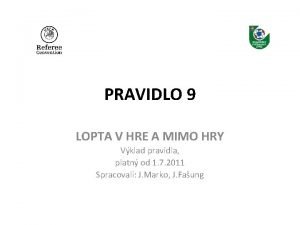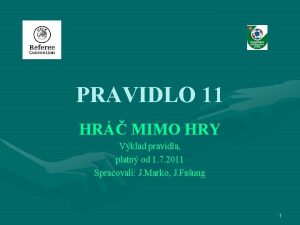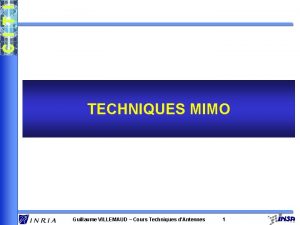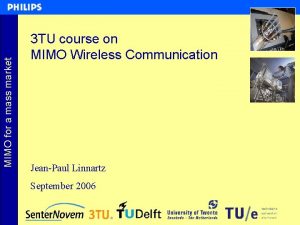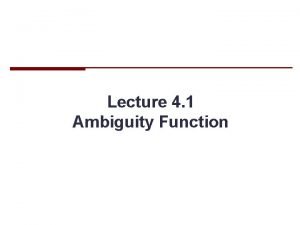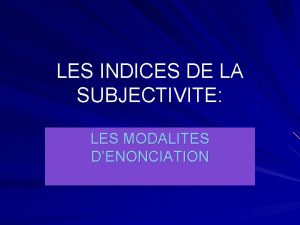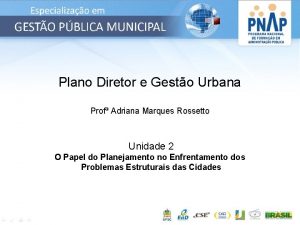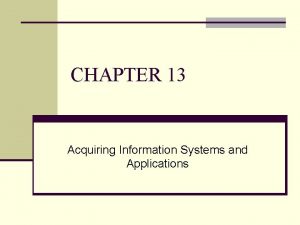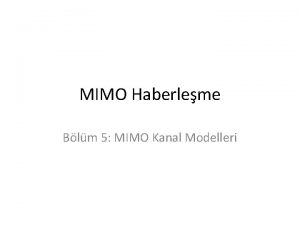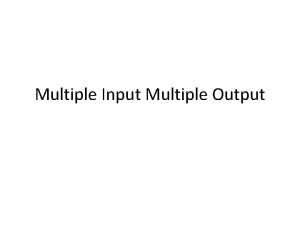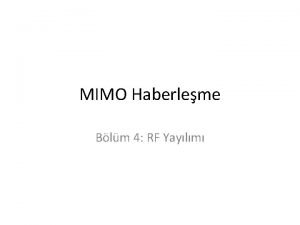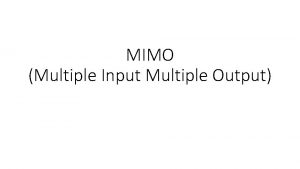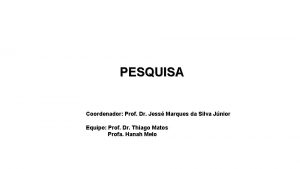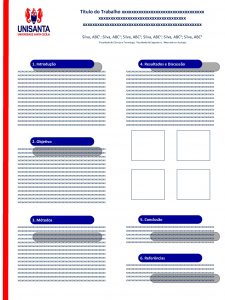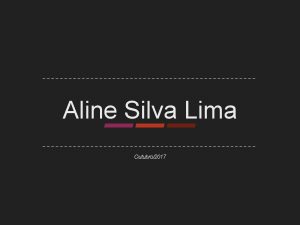MIMO Systems and Applications Mrio Marques da Silva































- Slides: 31

MIMO Systems and Applications Mário Marques da Silva marques. silva@ieee. org 1 Wireless Communication and Network 2015, Baltimore, USA, September 2015

Outline • Introduction • System Characterization for MIMO types – – – • • Space-Time Block Coding (open loop) Selective Transmit Diversity (closed loop) Multi-Layer Transmission Space Division Multiple Access (SDMA) Beamforming Multi-User MIMO vs Single-User MIMO Coordinated Multi-Point Tx Multihop Relay MISO System specified for Directivity Conclusions 2 Wireless Communication and Network 2015, Baltimore, USA, September 2015

Introduction • 4 G systems is demanding high data rates, improved performance and improved spectral efficiency • Multi-antenna systems are used in order to push the performance or capacity/throughput limits as high as possible without an increase of the spectrum bandwidth, although at the cost of an obvious increase of complexity • Multi-antenna systems are regarded as: – – SISO (Single Input Single Output) SIMO (Single Input Multiple Output) MISO MIMO 3 Wireless Communication and Network 2015, Baltimore, USA, September 2015

System Characterization for MIMO Types • Types of MIMO systems: – – – Space-Time Block Coding (STBC) Selective Transmit Diversity (STD) Multi-layer Transmission Space Division Multiple Access (SDMA) Beamforming • Single-User MIMO vs Multi-User MIMO 4 Wireless Communication and Network 2015, Baltimore, USA, September 2015

Space-Time Block Coding (STBC) • Initially proposed by Alamouti in 1998 • Although STBC is essentially a MISO system, the use of receiver diversity makes it a MIMO • This is an open loop system (CSI is not required at the Tx side) • The transmitted signal is • The frequency domain received signal is Ant. 1 a 2 a 1 STC Encoder 2 T T 0 Wireless Communication and Network 2015, Baltimore, USA, September 2015 Ant. 2 a 1* -a 2* 2 T T 0 5

Space-Time Block Coding (STBC) • The Alamouti’s post-processing for two antennas comes • Defining and the post-processing comes • Finally, the decoded symbols come 6 Wireless Communication and Network 2015, Baltimore, USA, September 2015

Multi-Layer Transmission • STBC aims to improve performance • Nevertheless, 4 G systems aims to provide 1 Gb/s (nomadic) and 100 Mbps (mobile), which requires schemes able to increase throughput • This is normally achieved by Multi-Layer Transmission (also achieves improved spectral efficiency) – The throughput is increased by a factor M (number of Tx antennas) – The number of Rx antennas must be equal to or higher than the number of Tx antennas – The detection consists of “steering” the receive antennas to each one (separately) of the transmit antennas, in order to receive the corresponding data stream. This can be achieved through the use of the nulling algorithm 7 Wireless Communication and Network 2015, Baltimore, USA, September 2015

Multi-Layer Transmission • • Typically used in the uplink of cellular network (BS has more antennas than MS) The lowpass equivalent of the transmitted signals at the M antennas are respectively given by • Multi-layer MIMO Detectors: MLSE, MMSE, ZF, SIC, V-BLAST (Vertical – Bell Laboratories Layerd Space-Time), Lattice, etc. V-BLAST: • 1. 2. 3. The symbol of the Tx antenna with the highest SNR is first detected using a linear nulling algorithm such as Zero Forcing (ZF) or MMSE detector. The detected symbol is regenerated, and the corresponding signal portion is subtracted from the received signal vector using typically a SIC detector. This cancellation process results in a modified received signal vector with fewer interfering signal components left. This process is repeated, until all symbols are detected. 8 Wireless Communication and Network 2015, Baltimore, USA, September 2015

Space Division Multiple Access (SDMA) • SDMA allows multiple users exploiting spatial diversity as a multiple access technique, while using the same spectrum • Typically employed in the uplink of cellular network • Similar to multi-layer transmission, this belongs to the spatial multiplexing group, allowing the use of the V-BLAST detector (nulling w/ ZF/MMSE + SIC) 9 Wireless Communication and Network 2015, Baltimore, USA, September 2015

Beamforming • • Implemented by antenna array with array elements at the transmitter or receiver being closely located to form a beam Effective solution to maximize the SNIR, as it steers the transmit (or receive) beam towards the receive (or transmit) antenna, while reducing the interference generated to other users 10 Wireless Communication and Network 2015, Baltimore, USA, September 2015

Multi-User MIMO • • SU-MIMO considers data being transmitted from a single user into another individual user (widely used in the uplink) An alternative concept is the MU-MIMO, where multiple streams of data sent by a single transmitter (typically a BS) are simultaneously allocated to a certain user to increase throughput (or to multiple users to increase capacity), using the same frequency bands (and the Tx supports more antennas than the Rx) – • • • The approach behind MU-MIMO is similar to SU-MIMO multi-layer transmission. Nevertheless, while multi-layer Tx (or SDMA) is typically employed in the uplink, the MU-MIMO is widely implemented in the downlink This allows sending different streams of data to a certain User Equipment (UE), increasing the throughput (this is performed simultaneously for many UEs) In this case, instead of performing the nulling algorithm at the receiver side, the nulling algorithm needs to be performed using a pre-processing approach at the transmitter side (BS) – – • • When the aim is improved performance, instead of different streams of data, STBC or STD is employed This occurs because the BS can accommodate a high number of transmit antennas and the UE can only accommodate a single or reduced number (lower) of receive antennas Use pre-coding such as ZF, MMSE, dirty paper, etc. This typically requires downlink CSI at the Tx side (in FDD) Similar concept can be employed in Base Station Cooperation (Coordinated Multi-Point Transmission) and in Multihop Relaying to improve SNR or throughput at the cell edge Wireless Communication and Network 2015, Baltimore, USA, September 2015 11

Coordinated Multi-Point Transmission (Co. MP) • Co. MP Transmission is an important technique that can mitigate inter-cell interference, improve throughput, exploit diversity and, therefore, improve the spectrum efficiency. – Mitigates shadowing, path loss and inter-cell interference, at the Cell Edge. • • In case each BS uses the MIMO scheme, the resulting MIMO can be viewed as a "giant MIMO", consisting of a combination of independent antenna elements from different BSs Coordinated Multi-Point transmission (Co. MP) comprises the coordinated transmission of signals from adjacent base stations (BS), and the corresponding reception from UE. The signal received at the UE side consists of the sum of independent signals sent by different BSs. 12 Wireless Communication and Network 2015, Baltimore, USA, September 2015

Coordinated Multi-Point Transmission (Co. MP) • Three approaches for Co. MP: – Based on SU-MIMO (ex: using STBC or multi-layer transmission) – multilayer Tx requires that the number of Rx antennas be equal to or higher than number of BS’s – Based on MU-MIMO (requires pre-processing but simple receiver) – Based on a scheduling algorithm to coordinate BS Tx’s 13 Wireless Communication and Network 2015, Baltimore, USA, September 2015

Multihop Relay • • • Multihop relay is a technique that can improve the coverage and capacity by providing a homogenous service, regardless the users' positions, allowing high data rates for UE even at the cell edge. This is achieved by installing a number of Relay Stations (RS) that act as repeaters, between the BS and the UEs at the cell edge suffer from high propagation loss and high inter-cell interference from neighbor cells. Other UE reside in areas that suffer from strong shadowing effects or require indoor coverage from outdoor BS. These impairments originate a degradation of the SNR, which translates in a reduced service quality. Thus, the overall goal of multihop relay is to bring more power to the cell edge and into shadowed areas, while inducing minimal additional interference for neighbor cells. 14 Wireless Communication and Network 2015, Baltimore, USA, September 2015

MISO System specified for Directivity • Transmitters with directivity introduced at information level where the transmitted constellation is only optimized in the desired direction can be used for security purposes • Severely time-dispersive channels in broadband wireless systems => Use MIMO to improve spectral efficiency • The use of multilevel modulations in modern wireless standards leads to high peak-to-average power ratios and further drives the costs of power amplifiers while reducing their efficiency. 15 Wireless Communication and Network 2015, Baltimore, USA, September 2015

MISO System specified for Directivity • Power efficiency on Amplification can be improved, due to the fact that constellations are decomposed into several BPSK (Bi Phase Shift Keying) or QPSK components (Quadri-Phase Shift Keying), being each one separately amplified and transmitted independently by an antenna • Several users can coexist since each user must know the configuration parameters associated to the constellation configuration, i. e. , the direction in which the constellation is optimized, otherwise receives a degenerated constellation with useless data 16 Wireless Communication and Network 2015, Baltimore, USA, September 2015

MISO System specified for Directivity • FDE (Frequency-Domain Equalization) techniques are suitable for time-dispersive channels, namely the SC-FDE (Single Carrier – Frequency Domain Equalization) with multilevel modulations. – This leads to lower envelope fluctuations => efficient power amplification (OFDM signals present high envelope fluctuations) • IB-DFE receiver (Iterative Block Decision Feedback Equalization) are suitable for SC-FDE with multilevel modulations 17 Wireless Communication and Network 2015, Baltimore, USA, September 2015

Multilevel constellations • The constellation symbols can be expressed as a function of the corresponding bits as follows: for each . is the binary representation of i In matrix format we have where 18 Wireless Communication and Network 2015, Baltimore, USA, September 2015

Multilevel constellations • Examples: optimal 16 -Voronoi constellation (linear) • 16 -OQAM can be decomposed as a sum of four BPSK signals with the mapping rule defined by the set of non null complex coefficients 19 Wireless Communication and Network 2015, Baltimore, USA, September 2015

Transmitter Linear and Centered arrangements of sub-constellations in transmitter’s antennas for 16 -QAM and 16 Voronoi Wireless Communication and Network 2015, Baltimore, USA, September 2015 20

MISO System specified for Directivity Transmitter 21 Wireless Communication and Network 2015, Baltimore, USA, September 2015

MISO System specified for Directivity Receiver design The receiver does not require any processing, as the multiple components of the modulation are summed over-the-air, and combined in terms of phase, as long as the receiver is in the desired Do. A (alternatively, regular receive diversity can be employed). 22 Wireless Communication and Network 2015, Baltimore, USA, September 2015

MISO System specified for Directivity Simulation Environment • SC-FDE systems with multilevel modulations. • We considered 16 -QAM, 64 -QAM or Voronoi constellations, decomposed as as a sum of Nm BPSK components. • Antennas are equally spaced by d=λ/4 and the constellations are optimized for =75 o (under these conditions the directivity in the transmitted constellation is assured by phase rotations of the BPSK components). • AWGN channel and a severely time-dispersive channel are considered • Channel is modeled as a frequency selective fading Rayleigh channel characterized by an uniform PDP (Power Delay Profile), with 32 equalpower taps, with uncorrelated Rayleigh fading on each tap. 23 Wireless Communication and Network 2015, Baltimore, USA, September 2015

MISO System specified for Directivity Simulation results §The symbols sn are selected with equal probability from a M-QAM constellation (dimensions of M=16 and M=64 are considered). §The transmitter based on 16 -QAM with gray mapping is characterized by the set of non null coefficients 2 j, 1, 2 and j, associated to the antennas 1, 2, 3 and 4, respectively. 64 -QAM uses 6 non-null coefficients with values 2 j, 1, 2, j, 4 and 4 j associated to the antennas 1, 2, 3, 4, 5 and 6, respectively. 24 Wireless Communication and Network 2015, Baltimore, USA, September 2015

MISO System specified for Directivity Impact of an angle error regarding the transmission direction in BER performance of size-16 constellations using linear and centered arrangements. 25 Wireless Communication and Network 2015, Baltimore, USA, September 2015

MISO System specified for Directivity Impact of an angle error regarding the transmission direction in BER performance of size-64 constellations using linear and centered arrangements 26 Wireless Communication and Network 2015, Baltimore, USA, September 2015

MISO System specified for Directivity Analysis of Simulation Results § The impact of constellation's directivity on system's performance increases with the constellation’s size. §Higher directivity is assured by Voronoi constellations with a linear arrangement (uses 16 antennas, instead of 4 [16 -QAM] or 6 [64 -QAM]). §Increasing system’s spectral efficiency / higher modulation orders assures a better separation of the data streams transmitted for the different users. § Higher impact of angle errors for constellations that are decomposed in a higher number of sub-constellations (i. e. the case of Voronoi constellations). 27 Wireless Communication and Network 2015, Baltimore, USA, September 2015

MISO System specified for Directivity Linear array: BER performance for size-64 constellations with a frequency selective channel and an angle error against to transmission direction . 28 Wireless Communication and Network 2015, Baltimore, USA, September 2015

MISO System specified for Directivity Analysis of Simulation Results § When the angle error is null for 3 iterations of IB-DFE the performance is close to the Matched Filter Bound (MFB). §Due directivity errors (see 4º of error) other users are unable to decode efficiently the transmitted data (the constellation symbol is degenerated) § Voronoi constellations are the best choice. §Voronoi constellations achieves higher directivity but worse performance. 29 Wireless Communication and Network 2015, Baltimore, USA, September 2015

Conclusions § Results show that the proposed MIMO / MISO system achieves directivity, while degenerating the constellation signals in the other directions. § Directivity can increase with higher spectral efficiencies / higher order modulations. §Constellation shaping implemented by a MISO transmission structure achieves physical layer security. § Besides the aspects already mentioned, this approach also improves the power efficiency given the decomposition of multilevel constellations into constant envelope signals. § This facilitates the use of simplified non-linear amplifiers. Wireless Communication and Network 2015, Baltimore, USA, September 2015 30

Acknowledgements • This work was supported by FCT pluri-anual project IT UID/EEA/50008/2013 31 Wireless Communication and Network 2015, Baltimore, USA, September 2015
 Wgep
Wgep Molly spinelli
Molly spinelli Mrio board
Mrio board Lopta mimo hry
Lopta mimo hry Postavenie mimo hry
Postavenie mimo hry Memo ama a su mamá
Memo ama a su mamá Cours mimo
Cours mimo Mayamimo
Mayamimo Slide parnasianismo
Slide parnasianismo Não caracteriza a estética parnasiana
Não caracteriza a estética parnasiana Mimi urbani teocrito
Mimi urbani teocrito Mimo for dummies
Mimo for dummies Mimo
Mimo Groupe lvmh entreprises
Groupe lvmh entreprises Indice de subjectivité
Indice de subjectivité Abdel marques md
Abdel marques md Adriana marques rossetto
Adriana marques rossetto Adriana marques rossetto
Adriana marques rossetto Philip marques
Philip marques Alfredo marques gubern
Alfredo marques gubern Alfredo marques gubern
Alfredo marques gubern Profpedromarques
Profpedromarques Tarde llegaste marquez a volver arrepentido
Tarde llegaste marquez a volver arrepentido Logo des marques automobiles
Logo des marques automobiles Anna maria marques cintra
Anna maria marques cintra Ines pereira personagens
Ines pereira personagens Pere marquès graells
Pere marquès graells Calendario escolar aina moll
Calendario escolar aina moll Systems applications and products
Systems applications and products System applications and products in data processing
System applications and products in data processing Systems applications and products
Systems applications and products Steps for selecting and acquiring an information system
Steps for selecting and acquiring an information system



